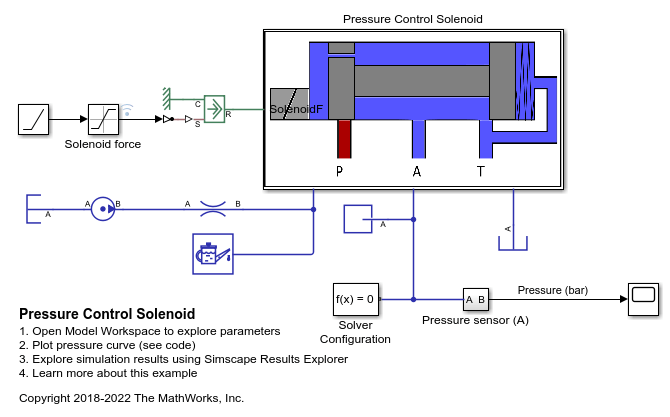Isothermal Liquid Predefined Properties (IL)
Set working fluid properties for an isothermal liquid network
Libraries:
Simscape /
Fluids /
Isothermal Liquid /
Utilities
Description
The Isothermal Liquid Predefined Properties (IL) block sets the working fluid liquid properties of your isothermal liquid network to the properties of a predefined fluid.
You can also model dissolved air in the system as a function of pressure. To specify your own working fluid properties, use the Foundation Library Isothermal Liquid Properties (IL) block. If you do not specify a fluid, the system defaults apply. See Specify Fluid Properties for more details.
Fluid Properties Range
You can set the block to model the properties of several predefined different liquids by using the Isothermal liquid parameter.
The block provides the water properties between the triple point, when the fluid
temperature and pressure reach 273.160 K and 611.657
Pa, and the critical point, when the fluid temperature reaches
647.096 K. Pmin
is set by the triple point or the saturation pressure, whichever is
greater.
The block provides the properties for ethylene-glycol, propylene-glycol, and glycerol are provided for temperatures above the solution freezing point. When you visualize properties, the displayed minimum temperature may be lower than the fluid freezing point. The block does not display updated temperatures for different mixture concentrations.
When you specify the mixture, you can define the concentration of ethylene glycol, propylene glycol, or glycerol to water by mass fraction or volume fraction by using the Concentration type parameter.
The block provides the properties for:
Concentration by mass between 0 and 0.6 and by volume between 0 and 1 for ethylene glycol.
Concentration by mass between 0 and 0.6 and by volume between 0.1 and 0.6 for propylene glycol.
Concentration by mass between 0 and 0.6 for glycerol. You cannot model glycerol concentration by volume.
The block stores the properties as a function of temperature and concentration. The block maintains all properties, except for density and the thermal expansion coefficient α, as constants for a range of pressures.
The block provides seawater properties for temperatures between 273.15
K and 393.15 K and for pressures above the
system saturation pressure. The salinity concentration can range from
0 to 0.12 by mass.
The block stores the properties as tabulated data with respect to pressure and temperature. The block derives the data from the Thermophysical properties of seawater software on the MIT website.
The block provides properties for a general, representative fuel mixture based on
Jet-A-4658 and Jet-A-3638 surrogates at temperatures between 222.22
K and 645.61 K and pressures above the
saturation point.
The block stores the properties as tabulated data with respect to pressure and temperature.
The block provides diesel properties for temperatures between 238.20 K
and 690.97 K and for pressures above the saturation
point.
The block provides SAE 5W-30 properties for temperatures between 235.15
K and 473.15 K and for pressures above
0.01 MPa. The block bases the properties at the system
temperature and atmospheric pressure measurements for temperatures between
29.85 °C and 74.85 °C (303
K to 348 K) and pressures between 7
MPa and 87 MPa. The block uses curve fits to
define properties in extrapolated regions.
The block uses numerical approximations to calculate fluid properties for these liquids:
SAE 30 OilSAE 50 Oil10W Oil30W Oil50W OilSkydrol LD-4Skydrol 500B-4Skydrol 5HyJet-IVAFluid MIL-F-83282Fluid MIL-F-5606Fluid MIL-F-87257ATF (Dexron III)ISO VG 22 (ESSO UNIVIS N 22)ISO VG 32 (ESSO UNIVIS N 32)ISO VG 46 (ESSO UNIVIS N 46)ISO VG 68Brake fluid DOT 3Brake fluid DOT 4Brake fluid DOT 5
The block uses the Walther equation to approximate changes in velocity, v, with respect to temperature, T
where a, b, and d are constants that are specific to each fluid.
The block assumes that the density, ρ, changes linearly with respect to temperature,
where:
α are constants that are specific to each fluid.
ρref is the fluid density at the reference temperature, Tref.
The bulk modulus, β, is
where c is the speed of sound. The block
uses c
= 1460 m/s as the speed of sound in hydraulic oils.
The block uses the same approximations as the lubricating oils and hydraulic fluids to
calculate the gasoline density and bulk modulus. In gasoline, the speed of sound
is 1250 m/s.
The Vogel-Fulcher-Tammann equation calculates the fluid viscosity for gasoline,
where v0, B, and T0 are constants.
Dissolved Air
You can optionally model air dissolved into the liquid system. If you select Model air dissolution, the block models dissolution between the values of the Atmospheric pressure parameter and the Pressure at which all entrained air is dissolved parameter by using Henry's law. For more information, see Fluid Models with Entrained Air.
Visualizing Fluid Properties
To visualize the fluid density and bulk modulus in your network, right-click the Isothermal Liquid Predefined Properties (IL) block and select Fluids > Plot Fluid Properties.

Use the Reload Data button to regenerate the plot when the fluid selection or fluid parameters change.
Examples
Ports
Conserving
Parameters
References
[1] Massachusetts Institute of Technology (MIT). Thermophysical properties of seawater database. http://web.mit.edu/seawater.
[2] K.G. Nayar, M.H. Sharqawy, L.D. Banchik, J.H. Lienhard V. "Thermophysical properties of seawater: A review and new correlations that include pressure dependence." Desalination 390 (July 2016): 1-24.
[3] M.H. Sharqawy, J.H. Lienhard V, S.M. Zubair. "Thermophysical properties of seawater: A review of existing correlations and data." Desalination and Water Treatment 16, no. 1-3 (april 2010): 354-380.
[4] I.H. Bell, J. Wronski, S. Quoilin, V. Lemort. "Pure and Pseudo-pure Fluid Thermophysical Property Evaluation and the Open-Source Thermophysical Property Library CoolProp." Industrial & Engineering Chemistry Research 53, no. 6 (February 12, 2014): 2498–2508.

